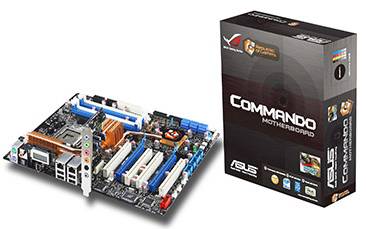
The Commando is part of the R.O.G. (Republic of Gamers) family of gaming motherboards. In its labs ASUS was able to overclock the FSB to 2,280MHz and the memory to 1,300MHz. The specifications of their test system aren't listed in their press release but they did include a screenshot of Super PI and CPU-Z. The screenshot is pretty small and hard to read but I think they used a Core 2 Extreme X6600 processor.
The ASUS Commando supports dual-core and quad-core Core 2 processors from Intel and accepts 533/667/800MHz memory modules. It features Intel's P965 chipset and the ICH8R southbridge and supports a FSB of 800MHz and 1066MHz. It has six Serial ATA 3Gbps ports and has support for ATI CrossFire. It also features SupremeFX ADI 1988b built-in audio.
Some other special features:
8-phase cap-less power – Reliable power supply and longer component life
The 8-phase cap-less power design demonstrates two hardcore commitments of R.O.G.: ultimate overclocking capability, and trustworthy stability. 8-phase cap-less power yields unparalleled superiority in the overclocking arena, while the EL cap-less design removes any worries of capacitor problems once and for all.
Onboard Switch – Turn system on/off, reset and clear CMOS with one push of a button
Overclockers and power users typically build systems outside of the case, and hence they need to short the front panel pins to power up or restart the system, switch jumpers, and pop the battery to clear CMOS. With the Commando, doing all that is now just a push of a button.
LCD Poster – Easy System Tweaking with Style
Most hardcore users and engineers install a debug card, which displays a two-digit code that enables them to recognize which part of the system is responsible for hanging the system during boot-up. LCD Poster, located at the back I/O, displays the names of each boot-process instead of using codes. When system hangs due to faulty connection or configuration, the LCD Poster will freeze on the displayed process name that caused the hang up, allowing users to know exactly what needs to be fixed.